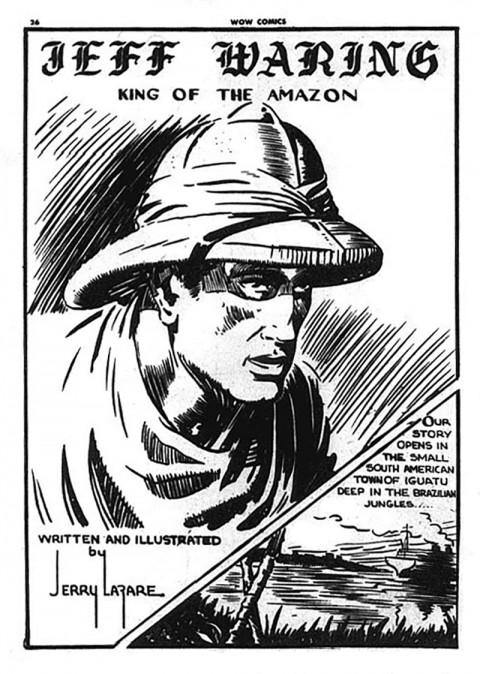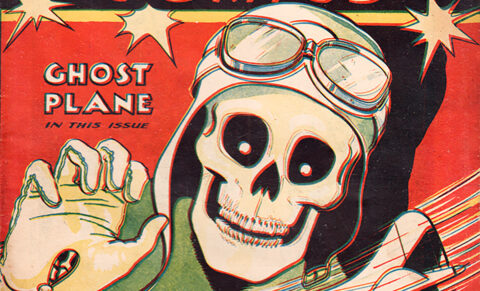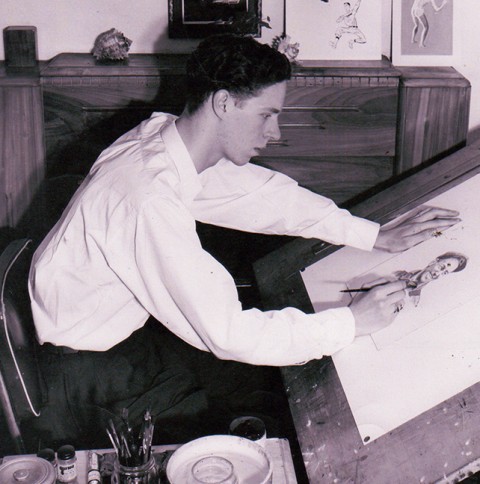
Gerald Lazare was born in Toronto on September 25, 1927 to parents who lived in the Junction and operated a millinery. As a four or five year-old , when his older half-brother visited on weekends, he would watch him making drawings from the pages of Sunday newspaper comic inserts and soon began copying him. From that time on found that he loved drawing and the act of creating images on a blank page. This impulse to art came to be his central empowering force, constantly cultivated and bearing bountiful fruit right up to this day.
As he came to experience the world of comic books and strips, the work of Alex Raymond, Noel Sickles, and Will Eisner became objects of admiration and he has cited Raymond many times as his chief inspiration. Radio programs such as The Shadow, Gang Busters, and The Lone Ranger fed his imagination and stimulated his artistic visualization.
By the time he was in third year at Oakwood Collegiate (Canadians will remember the names of other Oakwood alumni such as Patrick Watson, Frank and Harry Rasky, Stephen Lewis, and Pink Floyd producer Bob Ezrin as well as Bell Features artist and later well-known abstract painter, Ross Mendes) he had become familiar with the American comic books that had been available before the government’s War Exchange Conservations Act (WECA – I use this acronym as a description of the period 1941-46 when these distinct war-time Canadian comics were produced, bracketed by the parliamentary implementation of the act and then the gradual repeal of it once the Second World War was over) closed the door on them by the start of 1941 and also with the Bell Features Canadian comics produced locally that had taken their place. Dreaming about working in art in some capacity, Lazare mailed some samples of his work in to the Bell Features offices asking for advice on how he could improve it. About a week later Gerald got a call back from Cy Bell asking him if he was ready to start working for the company and drawing comics.
He was still 15 and he began his comic career by taking over the Jeff Waring strip from Murray Karn who had just entered the armed forces and Lazare’s first story was “Jeff Waring Meets the Giant of Doom” which appeared in Wow Comics 17 (Oct./Nov. 1943 – Bell Features was notorious for not publishing cover dates on most of their comics and the ones I provide in parentheses are my best estimates).
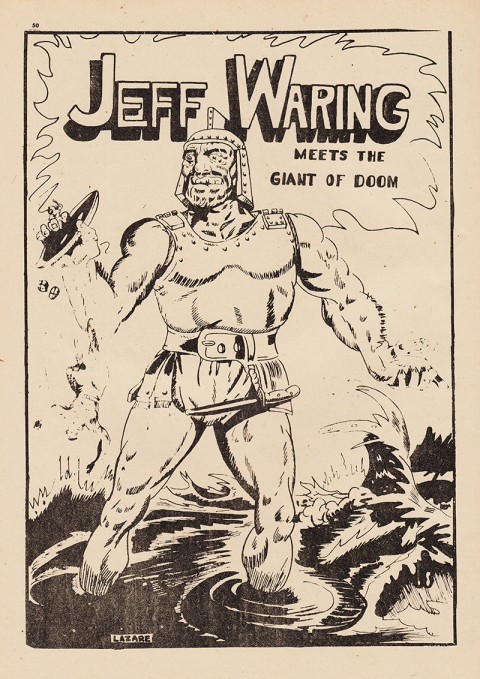
These first 3 or 4 Jeff Waring stories seemed to have been a sort of “trial period” for him. Dingle probably approved and Lazare quickly became a central cog in the Bell Features machine. Gerald, who most commonly signed his work as “Jerry Lazare” during his brief comic book period, continued to draw the Jeff Waring strip right up to Wow Comics 28 (Aug./Sept. 1945) until Murray Karn returned from the war to reclaim it for the last two issues of the title.
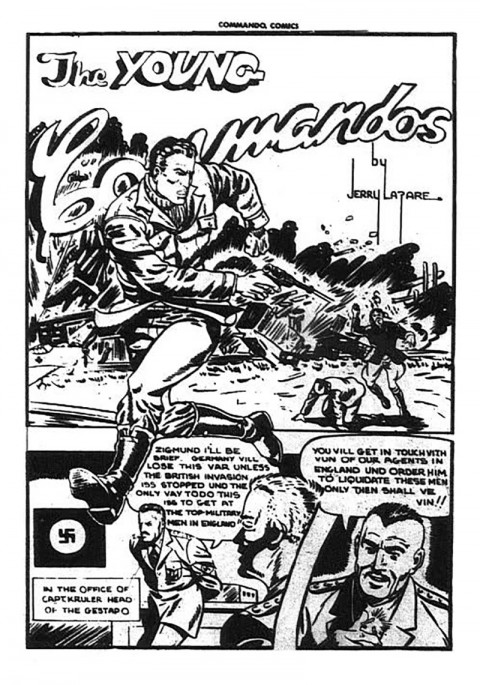
Lazare also took over the “Young Commandos” strip from Al Cooper in Commando Comics 8 (Nov./Dec. 1943) a strip originated by Mel Crawford in the first issue of that title. He continued to create the “Young Commandos” stories right through its transformation into “Ruff and Reddy” (named after the lead characters from the “Young Commandos” stories) in Commando Comics 20 (Nov./Dec. 1945) and 21 (Jan./Feb. 1946).
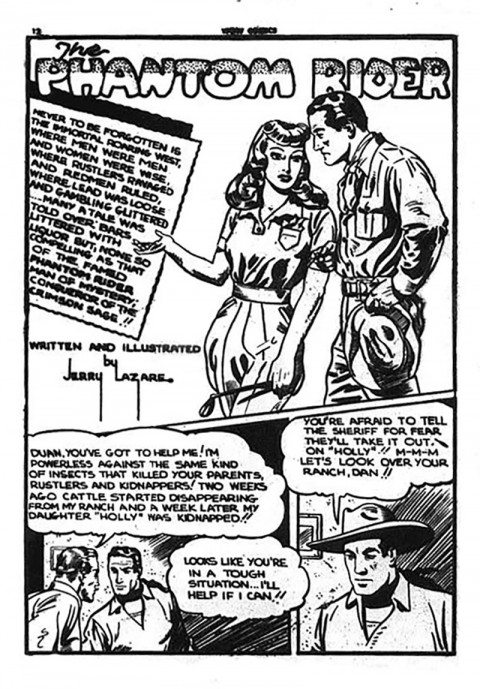
In Wow Comics 21 (June/July 1944) Lazare took over “The Phantom Rider” strip from Rene Kulbach who created it in Wow Comics 17 (Oct./Nov. 1943) and only did it for the next issue as well after which it lapsed until Lazare took over in issue 21 and did it up to issue 26 and one more story in the last issue of the title, No. 30. You can see from his early assignments for Bell that young Jerry Lazare was sort of a “relief pitcher” who was assigned the job of keeping successful strips going after the original artists, for some reason or other, were no longer able to contribute to them.
Perhaps it was for this reason that, around the same time, in Joke Comics 14 (June/July 1944) Jerry was assigned the revival of a character from the early days of Bell Features, the “other female hero” in the Bell family, The Wing, who was originally created by pulp cover artist John Hilkert in Joke Comics 3 and whose last previous appearance was in Joke Comics 6 (Jan./Feb. 1943). Lazare continued to create The Wing strips up to Wow Comics 25 (April/May 1946).
However, Lazare’s work at Bell Features was not restricted to just “taking over” other people’s strips. Just around the same time that he was beginning his versions of The Phantom Rider and The Wing, Jerry Lazare came up with two of his own creations. In Dime Comics No. 14 (April/May 1944) Jerry introduced his own contribution to the superhero genre in the form of Nitro, the costumed alter ego of inventor Terry King. Nitro had no super powers but was more of a non-masked Batman-like figure who solved crimes with above normal strength, agility, and intelligence. The feature ran steadily up to Dime Comics No. 28 (Aug./Sept. 1946) and also appeared one time each in Commando Comics No. 21 (Jan./Feb. 1946) and Joke Comics No. 25 (Apil/May 1946).
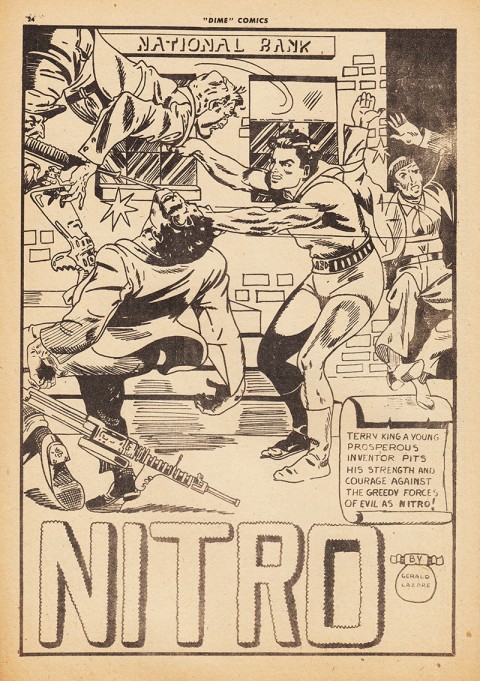
The second Lazare creation was Drummy Young, a dance band leader and drummer who also solved crimes that always seemed to crop up around him. His first appearance was in Dime Comics No. 15 (June/July 1944), one issue after the first appearance of Nitro. Drummy was born of much more originality than the template that Nitro followed and he reflected Lazare’s life-long love of jazz.
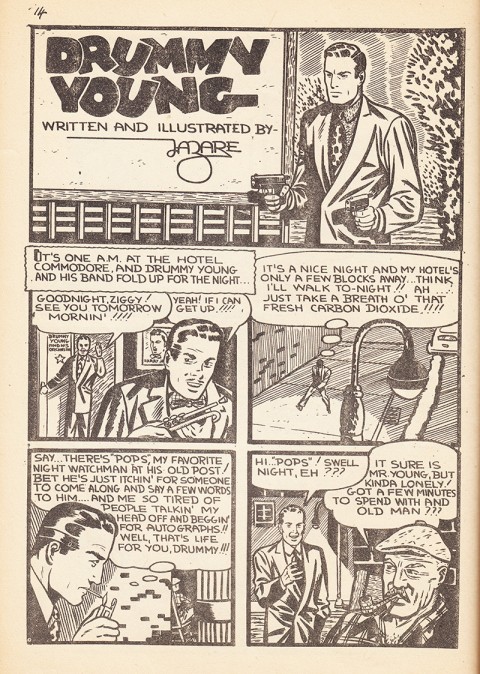
In Wow Comics No. 24 (Dec./Jan. 1944-5) Lazare introduced an innovative costumed hero called The Dreamer (“The Satan of Sleep”). His street identity was Dr. Kent Marlow, a psychiatrist who specialized in the interpretation of dreams and who after a fall down some stairs gained the power of seeing future crimes in his dreams. The strip ran right up to Wow Comics No. 30 (Dec./Jan. 1945-6), the last issue of the title. It’s important to note that, for 5 of the Bell Feature comics, Wow Comics Nos. 24-6 and Dime Comics Nos. 22 and 28, Jerry Lazare drew and wrote 3 stories each, making up just about a third of each issue.
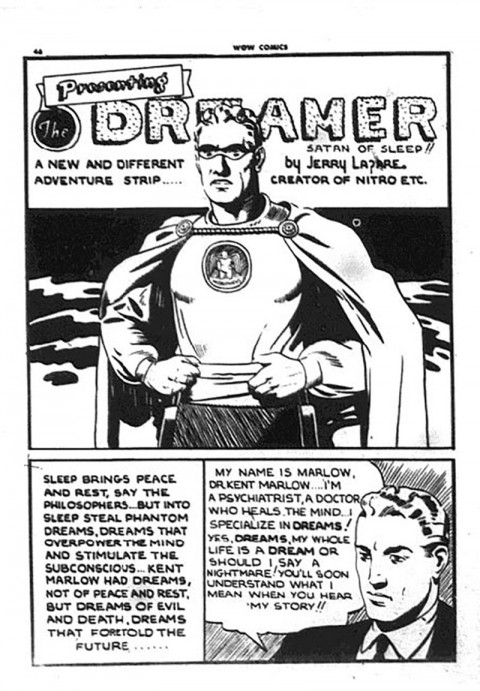
Lazare also had one more short-lived series in post-war Bell Features comics called Tommy Tweed. This began in Commando Comics 19 (Sept./Oct. 1945) and appeared in two more issues No. 20 and the last issue of the series No. 22. Tommy is a young Canadian teenage boy who loses his job at the local barroom and decides to run away from home to find his fortune with his pal a black boy named Suds Bramblebush. On the way they run into a conclave of German prisoners of war who have escaped from Canadian internment camps and are trying to re-establish the Nazi regime starting on Canadian soil. Tommy and Suds manage to trip over the subversive activities of the post-war Nazis and are dragged in front of a firing squad only to be rescued by the Canadian army at the last minute.
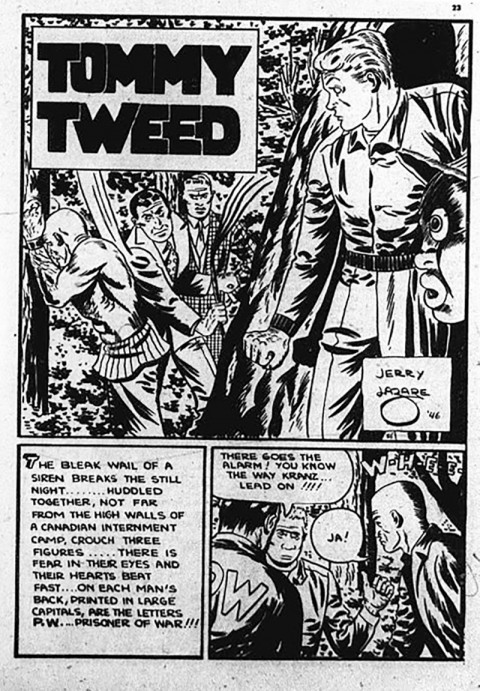
Gerald Lazare, in his first incarnation as young high school student Jerry, made a significant contribution to the last half of Bell Features WECA production and to the world of Canadian comics in general. He was among that surge of young teenage inspiration tapped into as a war-time resource by Cy Bell and Adrian Dingle that included Leo Bachle, Jack Tremblay, Ross Mendes, Al Cooper, Mel Crawford, Ed Shecter, Alfred Zusi and Aram Alexanian. I believe this injection of naivety and freshness is what set Bell Features a little apart from the other comic publishing houses of the period and in a positive way.
However, the years 1943-46 at Bell Features were just a formative sliver in the wider perspective of Gerald Lazare’s illustrious artistic career that included prolific advertising, book, and magazine illustration, teaching at the Ontario College of Art, as well excelling and flourishing in the world of fine art (see http://www.lazarestudio.com/).
Note: Leif Peng’s great Today’s Inspiration blob (http://todaysinspiration.blogspot.ca/ ) recently (the post for Monday, Aug. 10) began putting up a retrospective of Gerald Lazare’s career as a artist after his comic book work. It’s well worth a look as it unfolds because it is written by Gerry himself.
